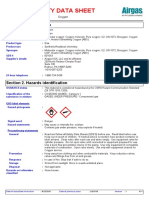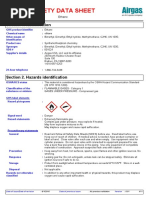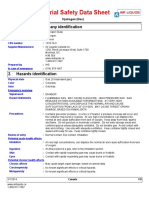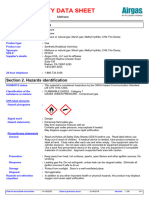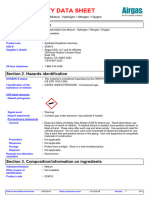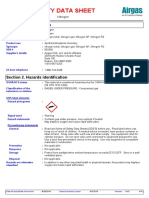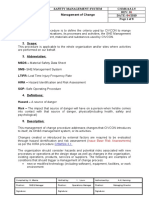Material Safety Data Sheet: Section 1. Chemical Product and Company Identification
Material Safety Data Sheet: Section 1. Chemical Product and Company Identification
Uploaded by
Henry OdulioCopyright:
Available Formats
Material Safety Data Sheet: Section 1. Chemical Product and Company Identification
Material Safety Data Sheet: Section 1. Chemical Product and Company Identification
Uploaded by
Henry OdulioOriginal Description:
Original Title
Copyright
Available Formats
Share this document
Did you find this document useful?
Is this content inappropriate?
Copyright:
Available Formats
Material Safety Data Sheet: Section 1. Chemical Product and Company Identification
Material Safety Data Sheet: Section 1. Chemical Product and Company Identification
Uploaded by
Henry OdulioCopyright:
Available Formats
Material Safety Data Sheet
Acetylene
Section 1. Chemical product and company identification
Product name : Acetylene
Supplier : AIRGAS INC., on behalf of its subsidiaries
259 North Radnor-Chester Road
Suite 100
Radnor, PA 19087-5283
1-610-687-5253
Product use : Synthetic/Analytical chemistry.
Synonym : Ethyne; Ethine; Narcylen; C2H2; Acetylen; UN 1001; Vinylene
MSDS # : 001001
Date of : 6/8/2009.
Preparation/Revision
In case of emergency : 1-866-734-3438
Section 2. Hazards identification
Physical state : Gas.
Emergency overview : WARNING!
FLAMMABLE GAS.
MAY CAUSE FLASH FIRE.
MAY CAUSE TARGET ORGAN DAMAGE, BASED ON ANIMAL DATA.
CONTENTS UNDER PRESSURE.
Keep away from heat, sparks and flame. Do not puncture or incinerate container. May
cause target organ damage, based on animal data. Use only with adequate ventilation.
Keep container closed.
Contact with rapidly expanding gases can cause frostbite.
Target organs : May cause damage to the following organs: upper respiratory tract, central nervous
system (CNS).
Routes of entry : Inhalation
Potential acute health effects
Eyes : Contact with rapidly expanding gas may cause burns or frostbite.
Skin : Contact with rapidly expanding gas may cause burns or frostbite.
Inhalation : Acts as a simple asphyxiant.
Ingestion : Ingestion is not a normal route of exposure for gases
Potential chronic health : CARCINOGENIC EFFECTS: Not available.
effects MUTAGENIC EFFECTS: Not available.
TERATOGENIC EFFECTS: Not available.
Medical conditions : Pre-existing disorders involving any target organs mentioned in this MSDS as being at
aggravated by over- risk may be aggravated by over-exposure to this product.
exposure
See toxicological information (section 11)
Section 3. Composition, Information on Ingredients
Name CAS number % Volume Exposure limits
Acetylene 74-86-2 100 NIOSH REL (United States, 6/2008).
CEIL: 2662 mg/m³
CEIL: 2500 ppm
Build 1.1 Page: 1/6
Acetylene
Section 4. First aid measures
No action shall be taken involving any personal risk or without suitable training.If it is suspected that fumes are still present,
the rescuer should wear an appropriate mask or self-contained breathing apparatus.It may be dangerous to the person
providing aid to give mouth-to-mouth resuscitation.
Eye contact : Check for and remove any contact lenses. Immediately flush eyes with plenty of water
for at least 15 minutes, occasionally lifting the upper and lower eyelids. Get medical
attention immediately.
Skin contact : In case of contact, immediately flush skin with plenty of water for at least 15 minutes
while removing contaminated clothing and shoes. To avoid the risk of static discharges
and gas ignition, soak contaminated clothing thoroughly with water before removing it.
Wash clothing before reuse. Clean shoes thoroughly before reuse. Get medical
attention immediately.
Frostbite : Try to warm up the frozen tissues and seek medical attention.
Inhalation : Move exposed person to fresh air. If not breathing, if breathing is irregular or if
respiratory arrest occurs, provide artificial respiration or oxygen by trained personnel.
Loosen tight clothing such as a collar, tie, belt or waistband. Get medical attention
immediately.
Ingestion : As this product is a gas, refer to the inhalation section.
Section 5. Fire-fighting measures
Flammability of the product :
Flammable.
Auto-ignition temperature :
304.85°C (580.7°F)
Flash point :
Closed cup: -18.15°C (-0.7°F).
Flammable limits :
Lower: 2.5% Upper: 82%
Products of combustion :
Decomposition products may include the following materials:
carbon dioxide
carbon monoxide
Fire hazards in the presence : Extremely flammable in the presence of the following materials or conditions: open
of various substances flames, sparks and static discharge, heat and oxidizing materials.
Fire-fighting media and : In case of fire, use water spray (fog), foam or dry chemical.
instructions
In case of fire, allow gas to burn if flow cannot be shut off immediately. Apply water from
a safe distance to cool container and protect surrounding area. If involved in fire, shut
off flow immediately if it can be done without risk.
Contains gas under pressure. Flammable gas. In a fire or if heated, a pressure
increase will occur and the container may burst, with the risk of a subsequent explosion.
Special protective : Fire-fighters should wear appropriate protective equipment and self-contained breathing
equipment for fire-fighters apparatus (SCBA) with a full face-piece operated in positive pressure mode.
Section 6. Accidental release measures
Personal precautions : Immediately contact emergency personnel. Keep unnecessary personnel away. Use
suitable protective equipment (section 8). Shut off gas supply if this can be done safely.
Isolate area until gas has dispersed.
Environmental precautions : Avoid dispersal of spilled material and runoff and contact with soil, waterways, drains
and sewers.
Methods for cleaning up : Immediately contact emergency personnel. Stop leak if without risk. Use spark-proof
tools and explosion-proof equipment. Note: see section 1 for emergency contact
information and section 13 for waste disposal.
Build 1.1 Page: 2/6
Acetylene
Section 7. Handling and storage
Handling : Use only with adequate ventilation. Use explosion-proof electrical (ventilating, lighting
and material handling) equipment. High pressure gas. Do not puncture or incinerate
container. Use equipment rated for cylinder pressure. Close valve after each use and
when empty. Keep container closed. Keep away from heat, sparks and flame. To avoid
fire, eliminate ignition sources. Protect cylinders from physical damage; do not drag, roll,
slide, or drop. Use a suitable hand truck for cylinder movement.
Storage : Keep container in a cool, well-ventilated area. Keep container tightly closed and sealed
until ready for use. Avoid all possible sources of ignition (spark or flame). Segregate
from oxidizing materials. Cylinders should be stored upright, with valve protection cap in
place, and firmly secured to prevent falling or being knocked over. Cylinder temperatures
should not exceed 52 °C (125 °F).
Section 8. Exposure controls/personal protection
Engineering controls : Use only with adequate ventilation. Use process enclosures, local exhaust ventilation or
other engineering controls to keep worker exposure to airborne contaminants below any
recommended or statutory limits. The engineering controls also need to keep gas, vapor
or dust concentrations below any lower explosive limits. Use explosion-proof ventilation
equipment.
Personal protection
Eyes : Safety eyewear complying with an approved standard should be used when a risk
assessment indicates this is necessary to avoid exposure to liquid splashes, mists or
dusts.
Skin : Personal protective equipment for the body should be selected based on the task being
performed and the risks involved and should be approved by a specialist before handling
this product.
Respiratory : Use a properly fitted, air-purifying or air-fed respirator complying with an approved
standard if a risk assessment indicates this is necessary. Respirator selection must be
based on known or anticipated exposure levels, the hazards of the product and the safe
working limits of the selected respirator.
The applicable standards are (US) 29 CFR 1910.134 and (Canada) Z94.4-93
Hands : Chemical-resistant, impervious gloves complying with an approved standard should be
worn at all times when handling chemical products if a risk assessment indicates this is
necessary.
Personal protection in case : Self-contained breathing apparatus (SCBA) should be used to avoid inhalation of the
of a large spill product.
Product name
Ethyne NIOSH REL (United States, 6/2008).
CEIL: 2662 mg/m³
CEIL: 2500 ppm
Consult local authorities for acceptable exposure limits.
Section 9. Physical and chemical properties
Molecular weight : 26.04 g/mole
Molecular formula : C2-H2
Melting/freezing point : Sublimation temperature: -81.8°C (-115.2°F)
Critical temperature : 35.3°C (95.5°F)
Vapor pressure : 635 (psig)
Vapor density : 0.9 (Air = 1)
Specific Volume (ft 3/lb) : 14.7058
Gas Density (lb/ft 3) : 0.0691
Build 1.1 Page: 3/6
Acetylene
Section 10. Stability and reactivity
Stability and reactivity : The product may undergo hazardous decomposition, condensation or polymerization,
react violently with water to emit toxic gases or become self-reactive under conditions of
shock or increase in temperature or pressure.
Incompatibility with various : Extremely reactive or incompatible with oxidizing agents
substances
Hazardous decomposition : Under normal conditions of storage and use, hazardous decomposition products should
products not be produced.
Hazardous polymerization : Under normal conditions of storage and use, hazardous polymerization will not occur.
Section 11. Toxicological information
Toxicity data
Chronic effects on humans : May cause damage to the following organs: upper respiratory tract, central nervous
system (CNS).
Other toxic effects on : No specific information is available in our database regarding the other toxic effects of
humans this material to humans.
Specific effects
Carcinogenic effects : No known significant effects or critical hazards.
Mutagenic effects : No known significant effects or critical hazards.
Reproduction toxicity : No known significant effects or critical hazards.
Section 12. Ecological information
Aquatic ecotoxicity
Not available.
Products of degradation : Products of degradation: carbon oxides (CO, CO2) and water.
Environmental fate : Not available.
Environmental hazards : No known significant effects or critical hazards.
Toxicity to the environment : Not available.
Section 13. Disposal considerations
Product removed from the cylinder must be disposed of in accordance with appropriate Federal, State, local
regulation.Return cylinders with residual product to Airgas, Inc.Do not dispose of locally.
Section 14. Transport information
Regulatory UN number Proper shipping Class Packing group Label Additional
information name information
DOT Classification UN1001 ACETYLENE, 2.1 Not applicable (gas). Limited
DISSOLVED quantity
Yes.
Packaging
instruction
Passenger
aircraft
Quantity
limitation:
Forbidden.
Cargo aircraft
Quantity
limitation:
15 kg
Build 1.1 Page: 4/6
Acetylene
TDG Classification UN1001 ACETYLENE, 2.1 Not applicable (gas). Explosive
DISSOLVED Limit and
Limited
Quantity
Index
0
Passenger
Carrying Ship
Index
75
Passenger
Carrying
Road or Rail
Index
Forbidden
Special
provisions
38, 42
Mexico UN1001 ACETYLENE, 2.1 Not applicable (gas). -
Classification DISSOLVED
“Refer to CFR 49 (or authority having jurisdiction) to determine the information required for shipment of the
product.”
Section 15. Regulatory information
United States
U.S. Federal regulations : United States inventory (TSCA 8b): This material is listed or exempted.
SARA 302/304/311/312 extremely hazardous substances: No products were found.
SARA 302/304 emergency planning and notification: No products were found.
SARA 302/304/311/312 hazardous chemicals: Ethyne
SARA 311/312 MSDS distribution - chemical inventory - hazard identification:
Ethyne: Fire hazard, reactive, Sudden release of pressure, Immediate (acute) health
hazard
Clean Water Act (CWA) 307: No products were found.
Clean Water Act (CWA) 311: No products were found.
Clean Air Act (CAA) 112 accidental release prevention: Ethyne
Clean Air Act (CAA) 112 regulated flammable substances: Ethyne
Clean Air Act (CAA) 112 regulated toxic substances: No products were found.
State regulations : Connecticut Carcinogen Reporting: This material is not listed.
Connecticut Hazardous Material Survey: This material is not listed.
Florida substances: This material is not listed.
Illinois Chemical Safety Act: This material is not listed.
Illinois Toxic Substances Disclosure to Employee Act: This material is not listed.
Louisiana Reporting: This material is not listed.
Louisiana Spill: This material is not listed.
Massachusetts Spill: This material is not listed.
Massachusetts Substances: This material is listed.
Michigan Critical Material: This material is not listed.
Minnesota Hazardous Substances: This material is not listed.
New Jersey Hazardous Substances: This material is listed.
New Jersey Spill: This material is not listed.
New Jersey Toxic Catastrophe Prevention Act: This material is not listed.
New York Acutely Hazardous Substances: This material is not listed.
New York Toxic Chemical Release Reporting: This material is not listed.
Pennsylvania RTK Hazardous Substances: This material is listed.
Build 1.1 Page: 5/6
Acetylene
Rhode Island Hazardous Substances: This material is not listed.
Canada
WHMIS (Canada) : Class A: Compressed gas.
Class B-1: Flammable gas.
Class F: Dangerously reactive material.
CEPA Toxic substances: This material is not listed.
Canadian ARET: This material is not listed.
Canadian NPRI: This material is listed.
Alberta Designated Substances: This material is not listed.
Ontario Designated Substances: This material is not listed.
Quebec Designated Substances: This material is not listed.
Section 16. Other information
United States
Label requirements : FLAMMABLE GAS.
MAY CAUSE FLASH FIRE.
MAY CAUSE TARGET ORGAN DAMAGE, BASED ON ANIMAL DATA.
CONTENTS UNDER PRESSURE.
Canada
Label requirements : Class A: Compressed gas.
Class B-1: Flammable gas.
Class F: Dangerously reactive material.
Hazardous Material : Health * 1
Information System (U.S.A.)
Flammability 4
Physical hazards 3
National Fire Protection :
4 Flammability
Association (U.S.A.)
Health 1 3 Instability
Special
Notice to reader
To the best of our knowledge, the information contained herein is accurate. However, neither the above-named
supplier, nor any of its subsidiaries, assumes any liability whatsoever for the accuracy or completeness of the
information contained herein.
Final determination of suitability of any material is the sole responsibility of the user. All materials may present
unknown hazards and should be used with caution. Although certain hazards are described herein, we cannot
guarantee that these are the only hazards that exist.
Build 1.1 Page: 6/6
You might also like
- Operation and Maintenance Manual Motor Grader CAT 16MDocument200 pagesOperation and Maintenance Manual Motor Grader CAT 16MRizal Assegaf80% (35)
- G.I. 2.721 - Electrical Arc Flash Mitigation PDFDocument15 pagesG.I. 2.721 - Electrical Arc Flash Mitigation PDFJoypee Macasampon100% (6)
- Instructions On How To Properly Fill in The WAIRDocument17 pagesInstructions On How To Properly Fill in The WAIRLauro CanceranNo ratings yet
- Manual Send TerexDocument64 pagesManual Send TerexAmérico Arone Huamaní86% (7)
- AcetyleneDocument6 pagesAcetylenemalimsaidi_160040895No ratings yet
- Material Safety Data Sheet: Section 1. Chemical Product and Company IdentificationDocument6 pagesMaterial Safety Data Sheet: Section 1. Chemical Product and Company IdentificationpetercrispNo ratings yet
- Material Safety Data Sheet: Section 1. Chemical Product and Company IdentificationDocument5 pagesMaterial Safety Data Sheet: Section 1. Chemical Product and Company IdentificationHafidzAliyufaNo ratings yet
- Material Safety Data Sheet: Section 1. Chemical Product and Company IdentificationDocument5 pagesMaterial Safety Data Sheet: Section 1. Chemical Product and Company IdentificationpetercrispNo ratings yet
- MethaneDocument7 pagesMethanedezfooli.sNo ratings yet
- Material Safety Data Sheet: Section 1. Chemical Product and Company IdentificationDocument7 pagesMaterial Safety Data Sheet: Section 1. Chemical Product and Company IdentificationSarmiento HerminioNo ratings yet
- Safety Data Sheet: Section 1. IdentificationDocument11 pagesSafety Data Sheet: Section 1. IdentificationchokielovrenNo ratings yet
- 001148 standardDocument11 pages001148 standardAli SakizadehNo ratings yet
- Msds AcetyleneDocument7 pagesMsds AcetyleneSyaifuddin Ma'rufNo ratings yet
- Msds IsobutanaDocument11 pagesMsds IsobutananikoNo ratings yet
- Material Safety Data Sheet: Section 1. Chemical Product and Company IdentificationDocument7 pagesMaterial Safety Data Sheet: Section 1. Chemical Product and Company IdentificationPraful E. PawarNo ratings yet
- Material Safety Data Sheet: Section 1. Chemical Product and Company IdentificationDocument6 pagesMaterial Safety Data Sheet: Section 1. Chemical Product and Company Identificationandy hamonanganNo ratings yet
- Safety Data Sheet: Section 1. IdentificationDocument11 pagesSafety Data Sheet: Section 1. IdentificationDan AlbertNo ratings yet
- Material Safety Data Sheet: Section 1. Chemical Product and Company IdentificationDocument5 pagesMaterial Safety Data Sheet: Section 1. Chemical Product and Company IdentificationAltif AboodNo ratings yet
- Safety Data Sheet: Section 1. IdentificationDocument11 pagesSafety Data Sheet: Section 1. IdentificationRam1zNo ratings yet
- Oxygen MSDSDocument9 pagesOxygen MSDSariNo ratings yet
- Welding Gas-ArgonDocument6 pagesWelding Gas-ArgonArpit MaheshwariNo ratings yet
- LPG SDSDocument8 pagesLPG SDSkevinNo ratings yet
- Safety Data Sheet: Section 1. IdentificationDocument11 pagesSafety Data Sheet: Section 1. Identificationmuhammadarif46No ratings yet
- Hydrogen MsdsDocument9 pagesHydrogen MsdsEmgr. Muhammad FahdNo ratings yet
- Methane SDSDocument15 pagesMethane SDSBhavani BudiNo ratings yet
- AIR LIQUIDE (MSDS) GAS-METHANE Expires 17-07-02Document9 pagesAIR LIQUIDE (MSDS) GAS-METHANE Expires 17-07-02PubcrawlNo ratings yet
- Hydrogen MSDSDocument9 pagesHydrogen MSDSSyifaBahiijAmalia100% (1)
- n-BUTANE RAW MAT MSDSDocument11 pagesn-BUTANE RAW MAT MSDSJustin Marc EstiponaNo ratings yet
- Material Safety Data Sheet: Section 1. Chemical Product and Company IdentificationDocument5 pagesMaterial Safety Data Sheet: Section 1. Chemical Product and Company IdentificationFarizka Revita AnandaNo ratings yet
- Safety Data Sheet: Section 1. IdentificationDocument11 pagesSafety Data Sheet: Section 1. IdentificationSubburamNo ratings yet
- MSDS Methane - MergedDocument64 pagesMSDS Methane - MergedKiara RamdhawNo ratings yet
- 2021 Ramset Fuel SDSDocument7 pages2021 Ramset Fuel SDSharithNo ratings yet
- Dust-Off SDSDocument8 pagesDust-Off SDSAimee SchieweNo ratings yet
- Compressed Air CDADocument10 pagesCompressed Air CDASitha WisesaNo ratings yet
- Msds EthaneDocument7 pagesMsds Ethanenirmal_subudhiNo ratings yet
- MSDS - Propane (C3H8) Bal AIRDocument6 pagesMSDS - Propane (C3H8) Bal AIRsathish sivasamyNo ratings yet
- Safety Data Sheet: Section 1. IdentificationDocument10 pagesSafety Data Sheet: Section 1. IdentificationLeandro SteinbachNo ratings yet
- MSDS CH4 PDFDocument11 pagesMSDS CH4 PDFNdpNo ratings yet
- Argon MSDSDocument8 pagesArgon MSDSkokoNo ratings yet
- Nitrogen MSDSDocument6 pagesNitrogen MSDSEMINAT PRINCENo ratings yet
- Material Safety Data Sheet: Section 1. Chemical Product and Company IdentificationDocument5 pagesMaterial Safety Data Sheet: Section 1. Chemical Product and Company IdentificationpetercrispNo ratings yet
- MSDS Armix - GasessDocument5 pagesMSDS Armix - GasessyusepNo ratings yet
- Msds Sulfur Hexafluoride - AirgasDocument11 pagesMsds Sulfur Hexafluoride - AirgastolmiltNo ratings yet
- Safety Data Sheet: Section 1. IdentificationDocument10 pagesSafety Data Sheet: Section 1. IdentificationReniNo ratings yet
- 125 Anfo - AmexDocument5 pages125 Anfo - AmexJoyas MicaNo ratings yet
- Msds NitrogenDocument10 pagesMsds NitrogenNga JengjeheNo ratings yet
- Compressed Air - AirgasDocument10 pagesCompressed Air - AirgasBSB Material ControllerNo ratings yet
- Safety Data Sheet: Section 1. IdentificationDocument11 pagesSafety Data Sheet: Section 1. IdentificationRinaldi ArazaquNo ratings yet
- Safety Data Sheet: Section 1. IdentificationDocument11 pagesSafety Data Sheet: Section 1. IdentificationAdam RizkyNo ratings yet
- SiH4 MSDSDocument11 pagesSiH4 MSDSGurumoorthy ChandranNo ratings yet
- Nitrous OxideDocument8 pagesNitrous OxideFa RaNo ratings yet
- Msds of OxygenDocument7 pagesMsds of OxygensahilchemNo ratings yet
- Msds Ethyl Oxide (Gas Eto)Document15 pagesMsds Ethyl Oxide (Gas Eto)ReniNo ratings yet
- Safety Data Sheet: Section 1. IdentificationDocument12 pagesSafety Data Sheet: Section 1. Identificationraja duraiNo ratings yet
- Material Safety Data Sheet: Section 1. Chemical Product and Company IdentificationDocument4 pagesMaterial Safety Data Sheet: Section 1. Chemical Product and Company IdentificationpetercrispNo ratings yet
- Material Safety Data SheetDocument7 pagesMaterial Safety Data SheetLaarnie ManalastasNo ratings yet
- Isobutylene C4H8 Safety Data Sheet SDS P4614Document8 pagesIsobutylene C4H8 Safety Data Sheet SDS P4614Wayan PartaNo ratings yet
- Safety Data Sheet: Section 1. IdentificationDocument13 pagesSafety Data Sheet: Section 1. IdentificationJustin ChongNo ratings yet
- Nitrogen MsdsDocument6 pagesNitrogen MsdssalcabesNo ratings yet
- Safety Data Sheet: Medline Gel Hand Sanitizer Section 1. IdentificationDocument9 pagesSafety Data Sheet: Medline Gel Hand Sanitizer Section 1. Identificationadien SuradeNo ratings yet
- Safety Data Sheet: Section 1. IdentificationDocument11 pagesSafety Data Sheet: Section 1. IdentificationAsh YehiaNo ratings yet
- After a Disaster - Information to Help You and Your Family RecoverFrom EverandAfter a Disaster - Information to Help You and Your Family RecoverNo ratings yet
- MDARR No 1 First Revision November 15Document26 pagesMDARR No 1 First Revision November 15popopioNo ratings yet
- Fema 2003Document420 pagesFema 2003Shannon Ryan100% (1)
- X-Pando Pipe Joint Compound SDS (Us) 3-9-16Document5 pagesX-Pando Pipe Joint Compound SDS (Us) 3-9-16StevenFerrelNo ratings yet
- Operating Instruction: MAN Marine Diesel Engines D2868 LE4XX / D2862 LE4XXDocument112 pagesOperating Instruction: MAN Marine Diesel Engines D2868 LE4XX / D2862 LE4XXOveis DarvishiNo ratings yet
- Ehs Policy and ProceduresDocument12 pagesEhs Policy and ProceduresAlvin James GuintoNo ratings yet
- Operators Manual M15Document88 pagesOperators Manual M15SMM ENTREPRISENo ratings yet
- Ec Safety Data Sheet: Adsint® Pa12 NaturDocument9 pagesEc Safety Data Sheet: Adsint® Pa12 NaturIrina DesyatykhNo ratings yet
- Safety Data Sheet: Fluoroantimonic AcidDocument12 pagesSafety Data Sheet: Fluoroantimonic Acidjoe294410No ratings yet
- VDA Volume Product Safety and Conformity - February 2018 PDFDocument35 pagesVDA Volume Product Safety and Conformity - February 2018 PDFPatryk RączyNo ratings yet
- Confined Space Entry (CSE) Certification Training Standard: Workplace Health, Safety and Compensation ActDocument5 pagesConfined Space Entry (CSE) Certification Training Standard: Workplace Health, Safety and Compensation ActUdha Pengen SuksesNo ratings yet
- Module 1 - 3 PMTP LabDocument2 pagesModule 1 - 3 PMTP LabPeach Mango PieNo ratings yet
- First Aid Cases RecordDocument1 pageFirst Aid Cases RecordFrancis Enriquez TanNo ratings yet
- Axion Liq LimónDocument7 pagesAxion Liq Limónyenni viviana67% (3)
- Rerrry Presentation (En)Document40 pagesRerrry Presentation (En)Martynas PreisaitisNo ratings yet
- QuantumX Operating ManualDocument202 pagesQuantumX Operating ManualKristóf NémethNo ratings yet
- Concept Notes Workplace Safety Refers To The Working Environment at A Company and Encompasses All FactorsDocument3 pagesConcept Notes Workplace Safety Refers To The Working Environment at A Company and Encompasses All Factorssushi nakiriNo ratings yet
- Lecture 6Document16 pagesLecture 6Shaira Eiram ZayasNo ratings yet
- HIRADC Mobilisasi RIGDocument10 pagesHIRADC Mobilisasi RIGdvggfdhdbdfvbNo ratings yet
- C-SMS-4.3.1.5 Management of ChangeDocument8 pagesC-SMS-4.3.1.5 Management of Changecontrax8No ratings yet
- Željeznice Federacije ČlanakDocument13 pagesŽeljeznice Federacije ČlanakIsmarKalesicNo ratings yet
- Workplace Safety and Health Guidelines: Contractor ManagementDocument14 pagesWorkplace Safety and Health Guidelines: Contractor ManagementVernon GodseyeNo ratings yet
- JSA For HILTIDocument3 pagesJSA For HILTIMohammed Minhaj100% (1)
- 9 - LolerDocument8 pages9 - LolerEnrique RuizNo ratings yet
- Msds NitobenzeneDocument5 pagesMsds NitobenzeneAnngie Nove SimbolonNo ratings yet
- Cummins Prem Blue 15w40 1-18 L Sing Ssv3028m18 Asia-Pacific Purple Book (GHS) - EnglishDocument14 pagesCummins Prem Blue 15w40 1-18 L Sing Ssv3028m18 Asia-Pacific Purple Book (GHS) - EnglishjosephvanbacNo ratings yet
- OSHAquickfacts Lab Safety Chemical Fume Hoods PDFDocument2 pagesOSHAquickfacts Lab Safety Chemical Fume Hoods PDFacanis1016No ratings yet
















